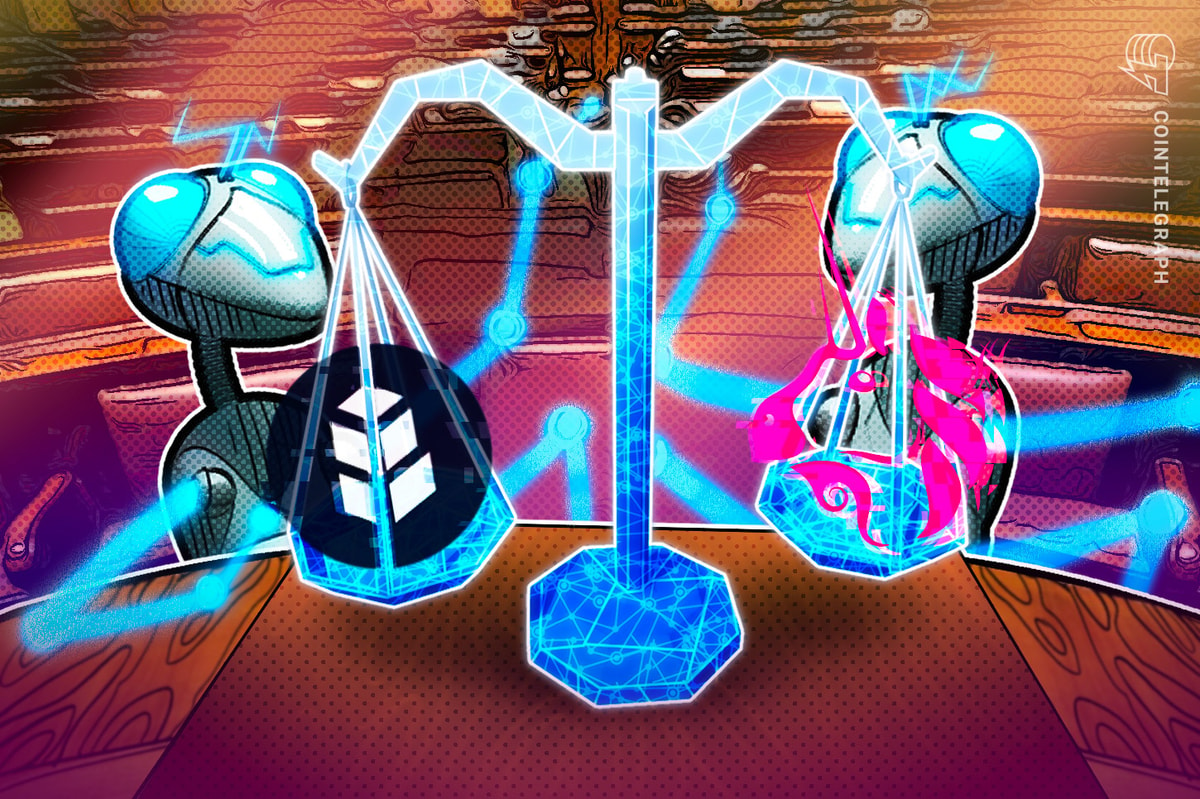
In many ways, the crypto bear market adage about building has been ideal for Aptos.
It took focus off the blockchain’s tokenomics, which drew a lot of criticism for being unveiled the day after its mainnet launch in October. A common refrain on Twitter at the time was that after raising $350 million at a valuation of more than $4 billion, Aptos should have been quicker to share details about how its native APT token had been distributed.
Now, after months of hosting hackathons and securing partnerships, the Aptos Foundation is planning a network upgrade and is revisiting its tokenomics with the goal of providing greater transparency.
“We are going to provide a little bit more clarity and more details behind the principles, and how we came to the decision that we made,” Mo Shaikh, Aptos CEO, told Decrypt. “But a lot of it all goes back to thinking about the people, so we’re gonna have a fairly detailed document that’s going to go live at some point.”
“Tokenomics” is a portmanteau of token and economics and in plain terms refers to the characteristics of a cryptocurrency that determine its value, such as its supply and distribution. Shaikh didn’t share any other details about how the team will add more clarity to its tokenomics, or say whether the update will change how tokens have so far been distributed.
As it stands now, APT has a total supply of 1 billion tokens. Of those, 51% has been earmarked for community initiatives, like grants for developers and incentives to bring more users onto the network. Another 16.5% was designated for the Aptos Foundation itself.
That amounts to 675 million tokens for those two categories. Of that, 130 million were immediately available when the Aptos network launched in October—125 million for community efforts and 5 million APT for the foundation. The rest is scheduled to unlock on a monthly basis over the next 10 years.
The remaining APT tokens were split among core contributors, who received 19% of the APT supply, and investors, who received 13.48%. That’s the remaining 355 million APT tokens. Both of those groups are subject to a 4-year lock up period, during which they can’t sell their tokens. But they can stake them with validators—the entities whose hardware keeps the network running—and earn interest.
Over time, staking rewards will increase the total supply of APT tokens. Between monthly unlocks and validator rewards, there are currently 162 million APT tokens in circulation, according to CoinGecko.
All of those details weren’t available until less than 24 hours before the token started trading on exchanges like FTX, Coinbase, and Binance. Which is why Aptos—and its investors, including FTX Ventures, Coinbase Ventures and Binance Labs—took so much criticism.
“Surely it should be a prerequisite to listing something that users can have the basic information on what they’re buying,” Up Only podcast host Cobie wrote on Twitter.
Shaikh also said the Aptos mainnet will be getting an update soon, although he didn’t specify when. Shaikh said the next version of Aptos will focus on “improving performance, continuing to provide scalability and also thinking about more efficiency in gas fees.”
Sure enough, someone on a recent Aptos developer call noted on Twitter that the network had “reopened the Testnet faucet.” It’s an incentive for developers, awarding them APT tokens for running code on the blockchain’s test network.
There’s been some recent attention on APT, but not because of the testnet. It started the year trading for $3.48 and then soared 385% to $16.90 on Friday, according to CoinGecko.
At least some of the price action seems to be linked to arbitrage traders who’ve been taking advantage of APT listing for higher prices on South Korean exchanges than elsewhere in the world, and Binance launching two APT liquidity pools, which pay users rewards for depositing their tokens.
“There’s not many tokens out there right now. Additionally, you have a large amount of short exposures, still,” Tom Dunleavy, a senior research analyst at Messari, told Decrypt. “So I think it’s simply just a short squeeze—a lot of it—in addition to some level of speculation.”
Investors can “short” a token, like APT, by opening a derivative contract to bet against it. Very simply put: If the price goes down, they make money. If it goes up, they lose money. A short squeeze happens when an asset surges in value due to a large number of traders “squeezing out” those short sellers.
A few months ago, there was a lot of interest in short selling APT. The outcry over the delayed release of its tokenomics led to traders lining up to short it.
Even so, by November Aptos had inked a partnership with Google Cloud. The company’s also running a validator on the Aptos network, but the tech giant isn’t playing favorites. It’s running a Solana validator, too.
One of the big drivers behind Aptos’s recent momentum has been the Move programming language, which was originally developed at Meta (formerly Facebook) for its Diem blockchain. When the project wound down it left Shaikh and co-founder Avery Ching, who had worked on Diem’s Novi wallet, free to start their own project.
As of December, Aptos had 248 total developers contributing to open-source projects in its ecosystem. That’s a 755% increase from the same time in 2021. But the ecosystem has a long way to go yet if it’s going to catch up to Solana, which had 2,082 total developers in December, according to data collected by venture capital firm Electric Capital.
Founded in 2018, Electric Capital counts decentralized exchange dYdX and centralized exchange Kraken among its portfolio. The firm isn’t an Aptos investor, but noted in its developer report that the blockchain has one of the fastest growing stables of developers.
“I suspect a lot of it is on the ground building developer community,” Avichal Garg, Electric Capital co-founder and partner, told Decrypt in an email. “They do a bunch of great events, for example. Part of it is also that a lot of engineers are excited about Move as a programming language.”
A key feature of the Move programming language has been that it’s especially easy to learn for developers who already know Rust, the language used to write smart contracts on Solana—the Goliath to Aptos’s David.
“From the developers that I’ve spoken with, it is a very quick transition from Rust to Move,” Dunleavy, the Messari analyst, said. “And Move is very sort of expressive in the things developers can do. So it’s fairly attractive there.”
For now, the Web3 developer community is small enough that there’s intense competition among projects.
“If you look at the Web3 space, there’s maybe thousands or tens of thousands of developers,” Shaikh said. “That’s relatively small compared to the rest of the developers in the world that are counted in millions.”
Since its inception, Aptos has been labeled a “Solana killer,” because it aims to solve the same problems as Solana. And Solana itself, which launched in 2019, was meant to be an Ethereum killer. Since then, Solana has been the faster and cheaper blockchain to transact on, but it’s also been plagued by network outages.
Two of the main metrics that blockchains compete on are speed and cost, which is why so much has been made of Aptos’s claims of 130,000 transactions per second. As for the gas fees, or the cost of completing a transaction on the network, Aptos wrote in December that it’ll be a major area of development in the first half of this year.
Shaikh also teased that the Aptos Foundation has been discussing partnerships with gaming and social media companies, saying that both will be big areas of focus in 2023.
Stay on top of crypto news, get daily updates in your inbox.
Read More: decrypt.co








 Bitcoin
Bitcoin  Ethereum
Ethereum  Tether
Tether  XRP
XRP  Solana
Solana  USDC
USDC  Dogecoin
Dogecoin  Cardano
Cardano  TRON
TRON  Lido Staked Ether
Lido Staked Ether  Wrapped Bitcoin
Wrapped Bitcoin  Sui
Sui  Wrapped stETH
Wrapped stETH  Chainlink
Chainlink  Avalanche
Avalanche  Stellar
Stellar  Hyperliquid
Hyperliquid  Shiba Inu
Shiba Inu  Hedera
Hedera  LEO Token
LEO Token  Bitcoin Cash
Bitcoin Cash  Toncoin
Toncoin  Litecoin
Litecoin  Polkadot
Polkadot  USDS
USDS  WETH
WETH  Monero
Monero  Wrapped eETH
Wrapped eETH  Bitget Token
Bitget Token  Binance Bridged USDT (BNB Smart Chain)
Binance Bridged USDT (BNB Smart Chain)  Pi Network
Pi Network  Pepe
Pepe  Ethena USDe
Ethena USDe  Coinbase Wrapped BTC
Coinbase Wrapped BTC  WhiteBIT Coin
WhiteBIT Coin  Aave
Aave  Uniswap
Uniswap  Bittensor
Bittensor  Dai
Dai  NEAR Protocol
NEAR Protocol  Aptos
Aptos  OKB
OKB  Jito Staked SOL
Jito Staked SOL  Ondo
Ondo  BlackRock USD Institutional Digital Liquidity Fund
BlackRock USD Institutional Digital Liquidity Fund  Tokenize Xchange
Tokenize Xchange  Cronos
Cronos  Official Trump
Official Trump